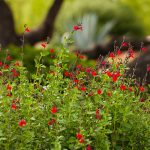We all know bluebonnets and firewheels, but there are rarer native gems that reside in several San Antonio parks — if you know where and what to look for.
We all know bluebonnets and firewheels, but the natural beauty of the San Antonio area doesn’t end there. Throughout San Antonio there are city parks that function more like wildlife preserves.
Within them reside rarer native plants, little gems that are often overlooked. You may not find these treasures in any nursery, but in my opinion they are one of the best arguments for maintaining wild spaces.
See these beauties for yourself — just head to a park near you and keep your eyes peeled.
 Texas plains Indian breadroot (Pediomelum latestipulatum): There are several species of breadroot that occur around San Antonio, but this variety is one of the easiest to find. I’ve seen them growing at Crownridge Canyon, Friedrich Wildernessand Eisenhower parks. They grow primarily along the Balcones Escarpment and sprout out of what looks like solid rock. I like to think of them as purple, perennial bluebonnets because breadroots are legumes, have five-petaled palmate leaves and bloom in the spring. Look for them during March and April. Once they’re finished blooming the tops break off and blow away like miniature tumbleweeds, spreading their seeds far and wide. An added bonus: the roots are edible, hence the name “breadroot.” But I enjoy the flowers too much to have ever dug one up to taste it.
Texas plains Indian breadroot (Pediomelum latestipulatum): There are several species of breadroot that occur around San Antonio, but this variety is one of the easiest to find. I’ve seen them growing at Crownridge Canyon, Friedrich Wildernessand Eisenhower parks. They grow primarily along the Balcones Escarpment and sprout out of what looks like solid rock. I like to think of them as purple, perennial bluebonnets because breadroots are legumes, have five-petaled palmate leaves and bloom in the spring. Look for them during March and April. Once they’re finished blooming the tops break off and blow away like miniature tumbleweeds, spreading their seeds far and wide. An added bonus: the roots are edible, hence the name “breadroot.” But I enjoy the flowers too much to have ever dug one up to taste it. Spiked crested coralroot orchid (Hexalectris spicata): These orchids are scattered under “old growth” trees like cedars and oaks in canyons and draws. Look for red oaks, shin oaks and black cherries growing together; it’s in these locations where forest soils are fully developed and the coralroot orchids are dependent upon as they are parasitic plants obtaining all nutrients and energy from their hosts via the fungi. While this seems a precarious way to live, coralroots are relatively abundant. I’ve seen them growing at Eisenhower, Mud Creek and Friedrich Wilderness parks. Look for their brief appearance from April to July.
Spiked crested coralroot orchid (Hexalectris spicata): These orchids are scattered under “old growth” trees like cedars and oaks in canyons and draws. Look for red oaks, shin oaks and black cherries growing together; it’s in these locations where forest soils are fully developed and the coralroot orchids are dependent upon as they are parasitic plants obtaining all nutrients and energy from their hosts via the fungi. While this seems a precarious way to live, coralroots are relatively abundant. I’ve seen them growing at Eisenhower, Mud Creek and Friedrich Wilderness parks. Look for their brief appearance from April to July. Blue funnel-lily (Androstephium coeruleum): Starting in February, these tiny blue stars begin to appear. Each flower lasts only a short time and the final blooms fade in March, followed quickly by the aboveground leaves. While most people prize plants for the great size or abundance, I find the restraint of blue funnel-lily captivating. Its timing is also special, appearing in mid-February right before everything else. Keep an eye on two patches — one in Eisenhower Park and the other in Stone Oak Park. When you see them, you’ll know spring is on the way.
Blue funnel-lily (Androstephium coeruleum): Starting in February, these tiny blue stars begin to appear. Each flower lasts only a short time and the final blooms fade in March, followed quickly by the aboveground leaves. While most people prize plants for the great size or abundance, I find the restraint of blue funnel-lily captivating. Its timing is also special, appearing in mid-February right before everything else. Keep an eye on two patches — one in Eisenhower Park and the other in Stone Oak Park. When you see them, you’ll know spring is on the way. Texas desert rue or Texas dutchman’s breeches (Thamnosma texana): This is one of the more common plants on this list, but you may have missed it due to its small size. It can be found in dry soils in parks and vacant lots all over San Antonio from South Side Lions to Friedrich Wilderness Park. For most of the year its wispy stems and linear leaves blend in with the grass. Tiny yellow or red flowers appear from February to June and are generally covered in pollinators. The flowers give way to the most delightful seed pods shaped like tiny puffy pants. The black swallowtail butterfly uses Texas desert rue as its host plant and specialty nurseries might carry it for this reason.
Texas desert rue or Texas dutchman’s breeches (Thamnosma texana): This is one of the more common plants on this list, but you may have missed it due to its small size. It can be found in dry soils in parks and vacant lots all over San Antonio from South Side Lions to Friedrich Wilderness Park. For most of the year its wispy stems and linear leaves blend in with the grass. Tiny yellow or red flowers appear from February to June and are generally covered in pollinators. The flowers give way to the most delightful seed pods shaped like tiny puffy pants. The black swallowtail butterfly uses Texas desert rue as its host plant and specialty nurseries might carry it for this reason. Climbing milkweed vine (Funastrum cynanchoides):Climbing milkweed vine is in the same plant family as the milkweeds that monarchs use, but is overlooked because they don’t generally select it as a host plant (although I have seen the odd queen caterpillar on them). The flowers are quite showy and can appear throughout the summer and fall, sometimes en masse, transforming whatever they are growing on into mounds of white. Particularly large patches of climbing milkweed vine can be seen along the Mission Reach of the San Antonio River Walk and at Mitchell Lake Audubon Center.
Climbing milkweed vine (Funastrum cynanchoides):Climbing milkweed vine is in the same plant family as the milkweeds that monarchs use, but is overlooked because they don’t generally select it as a host plant (although I have seen the odd queen caterpillar on them). The flowers are quite showy and can appear throughout the summer and fall, sometimes en masse, transforming whatever they are growing on into mounds of white. Particularly large patches of climbing milkweed vine can be seen along the Mission Reach of the San Antonio River Walk and at Mitchell Lake Audubon Center.
The part of Texas we live in has an astounding variety of plants, adapted over the years to thrive under our harsh climatic conditions. Each of the plants mentioned here are vital members of the unique biotic communities that make Bexar County special.




